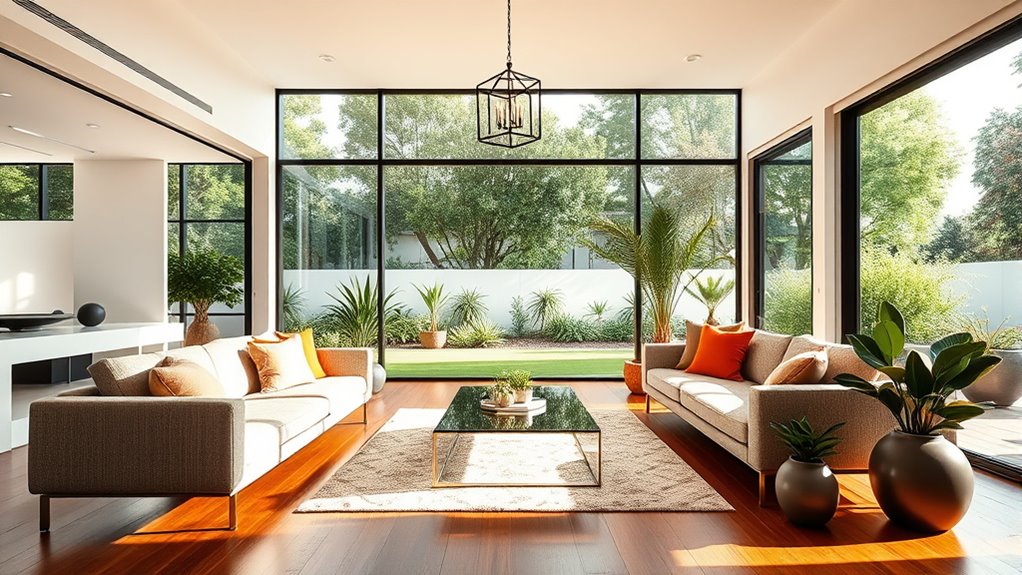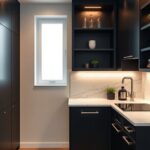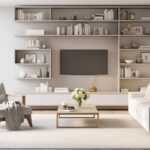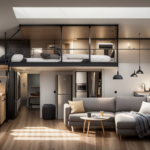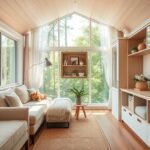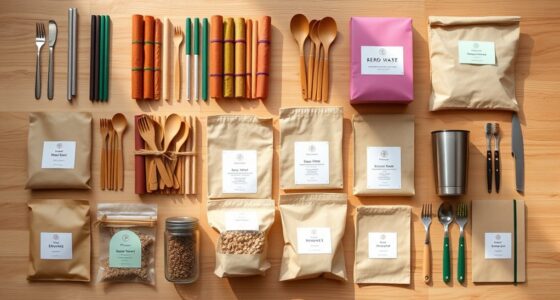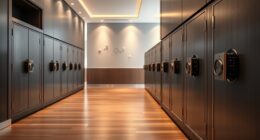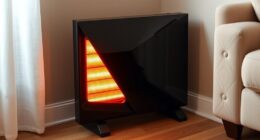If you’re looking to transform your space in 2025, consider balancing style and practicality with cozy, vintage-inspired decor or sleek, minimalist interiors to suit your vibe. Focus on thoughtful space planning, durable materials, and layered lighting for a welcoming ambiance. Incorporate flexible layouts and timeless finishes for future-proofing, and add statement rugs or accents for personality. Keep an eye on these key ideas, and you’ll find plenty of inspiration to refresh your home for the years ahead.
Key Takeaways
- Embrace rustic and vintage-inspired decor for cozy, inviting spaces that add charm and character.
- Incorporate minimalist, neutral palettes with texture-focused accents for a modern, serene look.
- Prioritize smart space planning and adaptable layouts to maximize functionality and flow.
- Select durable, high-quality materials like hardwood and natural stone for longevity and style.
- Layer lighting with ambient, task, and accent options to enhance ambiance and highlight design features.
Call It Home: The Details That Matter

If you love cozy, rustic styles that feel warm and inviting, then “Call It Home: The Details That Matter” is perfect for you. This beautiful coffee table book isn’t just pretty—it’s a work of art that elevates your decor. With an attractive brown spine and stunning visuals, it adds warmth and charm to any living space. Amber Lewis shares her design philosophy, focusing on creating inviting, vintage-inspired rooms with cozy palettes. I’ve used her ideas to update my home, and I find myself drawn into each page. It’s more than inspiration—it’s a thoughtful guide to making your space truly feel like home.
Best For: those who love cozy, rustic, vintage-inspired home decor and are looking for beautiful, accessible inspiration to create inviting spaces.
Pros:
- Stunning visual presentation that enhances home decor and looks great on a coffee table
- Offers thoughtful insights into design philosophy and personalized styling ideas
- Inspires warm, inviting, and affordable decorating approaches, especially for rustic and vintage styles
Cons:
- Some pages have white text on light backgrounds, making them difficult to read
- Slight damage to the album (rozklejony), affecting presentation quality
- Focuses more on inspiration and philosophy rather than detailed technical decorating tips
The Interior Design Handbook: Furnish, Decorate, and Style Your Space

The Interior Design Handbook: Furnish, Decorate, and Style Your Space is an ideal choice for anyone enthusiastic to understand the principles behind good interior design rather than simply copying popular styles. I find its focus on “why” and “how” invaluable, helping me develop a deeper understanding of room harmony and design logic. Instead of relying on glossy photos, it provides practical sketches and clear explanations, enabling me to plan with intention. This book’s educational approach empowers me to make cost-effective, personalized choices. It’s perfect for both beginners and seasoned decorators who want to craft authentic, well-balanced spaces rooted in solid design fundamentals.
Best For: individuals seeking a comprehensive, theory-based understanding of interior design principles to create personalized, balanced spaces without relying on superficial imagery.
Pros:
- Emphasizes “why” and “how” of design, fostering deeper understanding and skill development.
- Utilizes practical sketches and clear explanations for effective planning and execution.
- Suitable for both beginners and experienced decorators aiming for authentic, well-balanced interiors.
Cons:
- Lacks color photographs and room images, which may be less visually inspiring for some users.
- Focuses heavily on theory and principles, potentially requiring additional resources for style inspiration.
- Minor physical issues like worn covers, though generally well-made, may affect initial presentation.
New York School of Interior Design: Home
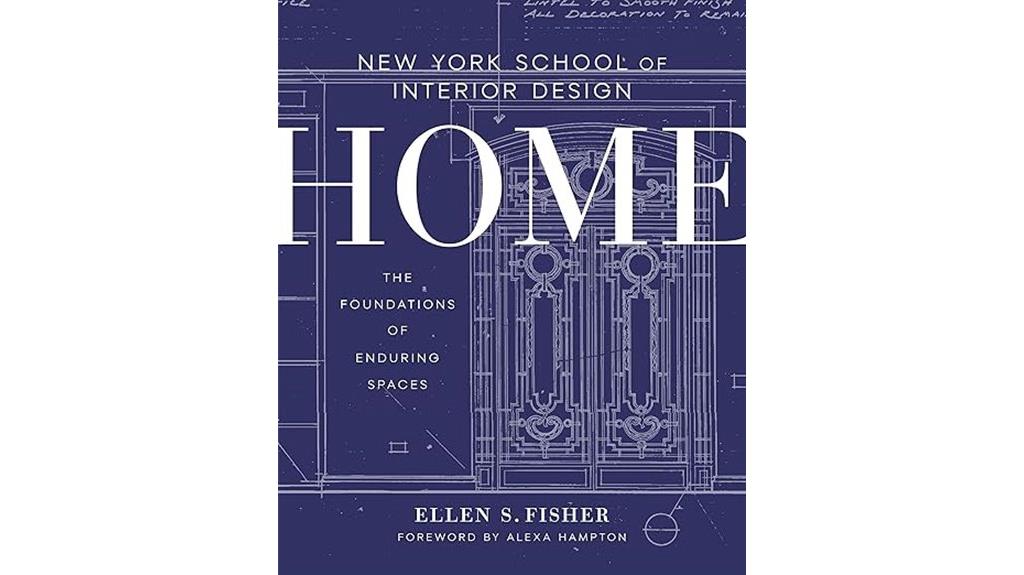
Looking for a thorough guide that blends aesthetic inspiration with practical advice? The New York School of Interior Design: Home is exactly that. It provides a detailed overview of interior design fundamentals like space planning, color theory, and outdoor living, making it perfect for beginners and pros alike. The book’s rich visuals—photos, illustrations, charts—make complex concepts easy to understand and inspiring to browse. Many use it as a quick reference for furniture placement, matching decor, and client communication. Its organized, beautiful design leaves a lasting impression, making it a must-have resource for anyone passionate about transforming their space in 2025.
Best For: beginners and professionals seeking a comprehensive, visually inspiring guide to interior design fundamentals and practical application.
Pros:
- Rich, high-quality visuals including photos, illustrations, charts, and tables that enhance understanding and inspiration
- Well-organized and thorough coverage of essential interior design topics like space planning, color theory, and client communication
- Serves as a versatile reference for quick guidance on furniture placement, decor matching, and design best practices
Cons:
- Some users experienced issues with shipping delays or loss of the physical copy
- May be too detailed for casual or purely aesthetic browsing without practical focus
- The extensive content might be overwhelming for complete beginners without prior background in design
Home by Design: Transforming Your House into Home

Are you seeking a practical guide that helps turn a house into a personalized, functional home? I found this book invaluable for home renovation projects, especially after events like house fires or downsizing. It opened my eyes to the bigger picture—lighting, space shaping, and connecting different areas. The ideas are clever, adaptable, and suited for any house size. I used it to plan accessible features and improve both exterior and interior design, incorporating architectural details like extended roofs and window tweaks. Even years later, I still refer to it for inspiration, making it a lasting resource for creating a truly personalized living space.
Best For: homeowners, remodelers, and DIY enthusiasts seeking practical, sustainable, and personalized home design guidance without professional architecture experience.
Pros:
- Offers clever, adaptable ideas suitable for houses of various sizes and styles.
- Emphasizes quality details, creating functional and aesthetically pleasing spaces.
- Includes visual resources like photographs and illustrations that aid understanding and planning.
Cons:
- Digital formats may have misaligned or obscured images, reducing clarity.
- Some readers find the layout or presentation of visuals less organized in e-books.
- The focus on architectural principles may be less detailed for advanced design professionals.
Made for Living: Collected Interiors for All Sorts of Styles

If you love elegant, understated interiors that emphasize simplicity and calm, “Made for Living: Collected Interiors for All Sorts of Styles” is an ideal choice. This beautifully photographed book offers a collection of refined spaces with neutral palettes and minimalist touches, perfect for inspiring a relaxed, collected look. It features thoughtful stories behind each design, focusing on textures, furniture placement, and accessories that create a serene atmosphere. Many readers find it a stylish, high-quality addition to their decor collection—great for flipping through for ideas or displaying as a coffee table masterpiece. It’s perfect for anyone who values subtle elegance and everyday comfort.
Best For: individuals who appreciate elegant, understated interiors with a focus on minimalism, neutral palettes, and thoughtful design stories.
Pros:
- Stunning photography and high-quality images that make it a visual delight.
- Offers practical inspiration for incorporating minimalistic and Scandinavian styles into home decor.
- Serves as a stylish coffee table book, perfect for display and repeated browsing.
Cons:
- Some buyers experienced damage upon arrival, such as marks, dents, or bent binding.
- International purchase and return processes can be challenging and inconvenient.
- Preferences for more vibrant or bold interior styles may find the book’s restrained aesthetic too subdued.
House + Love = Home: Creating Warm, Intentional Spaces for a Beautiful Life
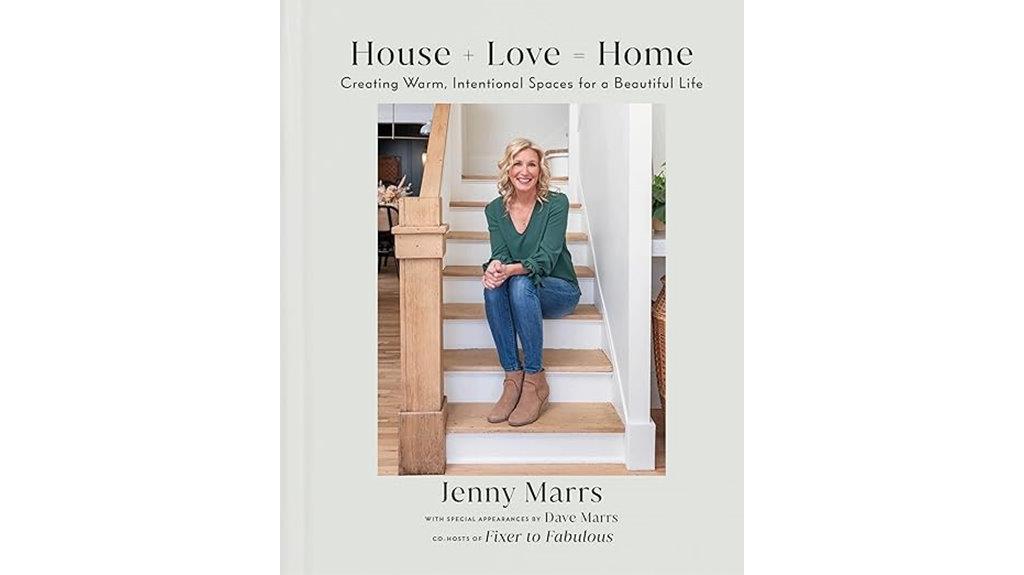
For anyone enthusiastic to transform their house into a warm, welcoming home filled with love and purpose, this book offers practical, heartfelt guidance. I love how it combines inspiring ideas, colorful photos, and personal stories that make decorating feel achievable and meaningful. It emphasizes creating cozy, intentional spaces where love and faith shine through, making your home a reflection of your values. Whether you’re planning small updates or big renovations, the advice is simple yet impactful. This book reminds us that home isn’t just about style — it’s about cultivating a space filled with joy, connection, and purpose.
Best For: those who love home decorating, family stories, and seeking inspiration to create warm, intentional living spaces filled with love and purpose.
Pros:
- Inspiring and uplifting tone that motivates readers to make meaningful home improvements
- Beautiful photos and practical tips suitable for small remodels or DIY projects
- Personal stories and family insights that make the content relatable and heartfelt
Cons:
- May contain religious undertones that not all readers find fitting
- Focused more on inspiration than detailed step-by-step instructions
- Could be considered more of a lifestyle and storytelling book rather than a comprehensive decorating guide
Ralph Lauren A Way of Living: Home, Design, Inspiration
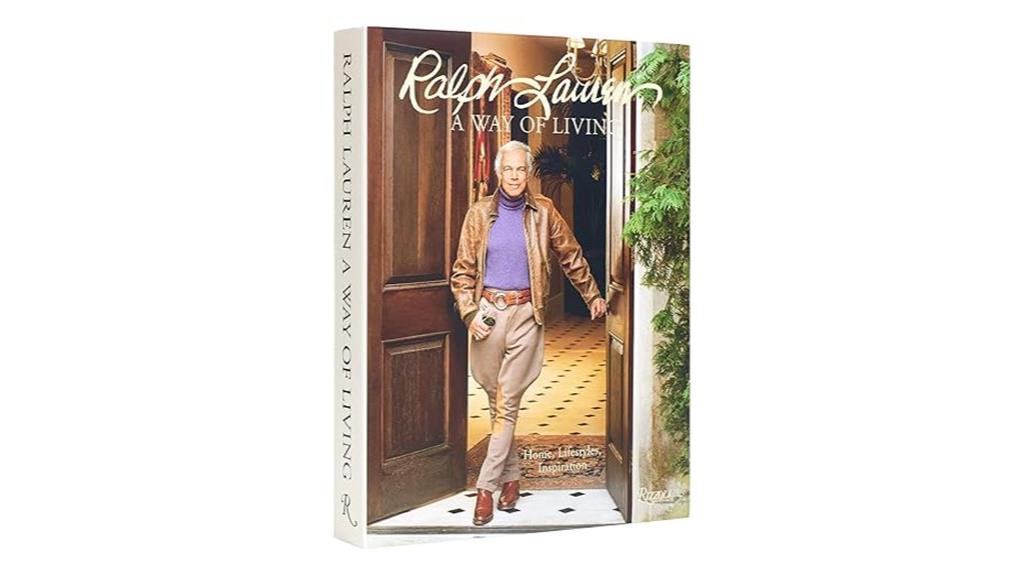
Ralph Lauren: A Way of Living is an ideal choice for anyone passionate about luxury home decor and timeless design. This hefty coffee table book showcases over 500 pages of stunning images, blending Ralph Lauren’s fashion, interior styles, and inspiration. I love how it highlights classic patterns like tartans, florals, and ticking prints, reflecting his signature aesthetic. The high-quality photography and elegant presentation make it a beautiful decorative piece. Even with some lower-resolution images, the book’s richness and Ralph Lauren’s heartfelt insights make it a treasured resource. It’s perfect for those seeking inspiration and a deeper connection to Ralph Lauren’s enduring lifestyle philosophy.
Best For: fans of Ralph Lauren, home decor enthusiasts, and collectors seeking a visually stunning, inspirational coffee table book that reflects timeless design and lifestyle.
Pros:
- Gorgeous photography and elegant presentation enhance its appeal as a decorative piece
- Over 500 pages of comprehensive images covering fashion, interiors, and design inspiration
- Personal insights from Ralph Lauren add depth and authenticity to the content
Cons:
- Some images, especially interior photos, are low resolution and may disappoint viewers
- The book is heavy and costly, which may be a consideration for some buyers
- A few copies arrive damaged or with content that may feel aspirational rather than practical
Mr. Pen House Plan and Drafting Tools Set of 3

The Mr. Pen House Plan and Drafting Tools Set of 3 is a game-changer for DIY home projects and professional design work. I find these templates incredibly useful—they include scaled house, furniture, and kitchen/bath fixtures, saving me time on drawing symbols manually. Made from flexible, shatter-resistant plastic, they’re durable and easy to handle, though some users note they could be a bit sturdier. The transparent material helps me see my plans clearly, and the set’s accuracy boosts my workflow. With over 8,700 ratings and a high 4.6-star average, these templates are a smart investment for anyone tackling home design or renovation in 2025.
Best For: DIY home enthusiasts, interior designers, and architecture students seeking accurate, easy-to-use drafting templates for residential planning and interior design projects.
Pros:
- High accuracy and consistency, saving time on manual symbol drawing
- Durable, shatter-resistant plastic material with high flexibility for ease of use
- Transparent templates allow clear visibility of underlying plans
Cons:
- Some users find the transparency excessive, which can hinder visibility
- Occasional reports of fragility, suggesting a need for denser material for durability
- Limited to 1/4 inch = 1 foot scale, which may not suit all project sizes
Keen Home Design Area Rugs 6×9 Non-Shedding Abstract Rugs

If you’re searching for a stylish, durable rug that enhances any indoor space, Keen Home Design’s 6×9 abstract area rug is an excellent choice. Made from high-quality polypropylene with a plush 0.3-inch pile, it offers both comfort and elegance. Its abstract skies beige pattern complements various decor styles, making it versatile for kitchens, living rooms, or bedrooms. The rug is water and stain resistant, with minimal shedding that’s easy to trim. Crafted in Türkiye, it provides durability and a sophisticated look, especially when paired with a rug pad. Customers love its vibrant color, softness, and ability to elevate their space effortlessly.
Best For: those seeking a stylish, durable indoor rug that adds comfort and elegance to living rooms, bedrooms, kitchens, or hallways.
Pros:
- Plush 0.3-inch high pile provides softness and comfort underfoot
- Water and stain resistant, ideal for high-traffic areas and easy maintenance
- Elegant abstract skies beige pattern complements various decor styles
Cons:
- May develop minor creases from folding that can take time to smooth out
- Thin profile benefits from use with a rug pad for stability and cushioning
- Not suitable for outdoor or water-exposed environments
Factors to Consider When Choosing Home Design & Renovation (25)
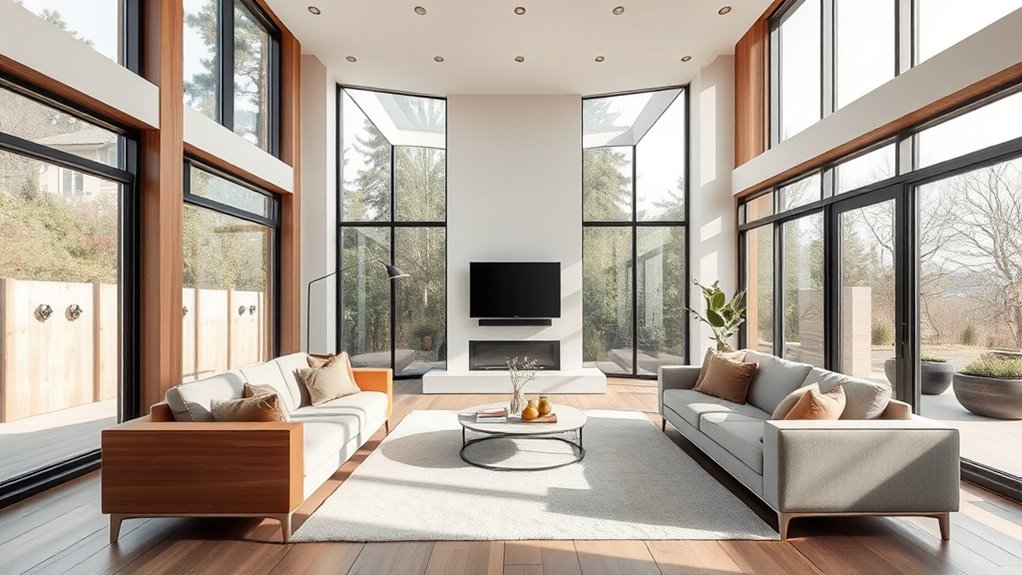
When planning a home design or renovation, I always start by considering my budget and how I want to allocate funds. I also think about the style I prefer and how it will fit with my space and layout needs. From there, I focus on choosing durable materials and creating the right lighting and ambiance to make the space truly my own.
Budget Constraints and Planning
Ever wonder how to make your home renovation both beautiful and budget-friendly? The key is starting with a clear budget. This helps you prioritize design choices and avoid overspending. I always recommend including a contingency fund of at least 10-20% of your total budget to cover unexpected costs. Understanding the differences in material, finish, and labor costs allows you to allocate funds wisely, focusing on critical areas. Creating a detailed, itemized project budget keeps spending in check and helps you stay on track financially. Additionally, exploring financing options like loans or grants can give you extra resources to enhance your plans without straining your finances. Proper budget planning guarantees your renovation is both stunning and financially sustainable.
Style Compatibility and Taste
Choosing the right design elements requires paying close attention to style compatibility and personal taste. I always start by ensuring new pieces or colors harmonize with my existing decor, color schemes, and architectural features. It’s important that my choices reflect what I love; otherwise, the space feels disconnected. When aiming for a specific look—be it modern, rustic, or traditional—I make sure every element supports that vision. Mixing styles can work, but only if I carefully balance scale, color, and patterns to avoid chaos. Maintaining consistency in style helps create a unified, pleasing environment. Ultimately, choosing designs that resonate with my preferences makes my home feel authentic and satisfying, turning my vision into reality without feeling mismatched or out of sync.
Space and Layout Needs
Evaluating the size and shape of my space is essential to make certain it can comfortably support my furniture and daily activities. I need to assess whether rooms are spacious enough for my lifestyle and consider the flow and accessibility of pathways, ensuring easy movement between areas. Thinking about the number and type of rooms I require helps me decide between open-plan layouts or segmented spaces, based on how I prefer to use each area. I also take into account natural light sources and window placements to enhance lighting and ventilation. Finally, I plan for future needs or potential expansions, making sure the layout remains adaptable as my household or preferences evolve. This careful assessment helps me create a functional, comfortable, and flexible home.
Material Durability Factors
Selecting durable materials is crucial to guarantee your home stands up to daily wear and environmental challenges. I look for high-quality fibers, like hardwood and natural stone, because they tend to last longer than softer or synthetic options. In high-traffic areas, I prioritize materials resistant to scratching, denting, and fading to ensure they maintain their appearance over time. For outdoor spaces or moisture-prone zones, weather-resistant and waterproof options such as treated wood or composite decking are essential. Proper maintenance, including regular cleaning and upkeep, can greatly extend the lifespan of these materials. I also consider how materials respond to environmental factors like UV exposure, temperature changes, and humidity to select finishes that will remain beautiful and durable for years to come.
Lighting and Ambiance
Lighting plays a crucial role in shaping the mood and functionality of a home, making spaces feel more inviting and easier to navigate. I recommend layering different types of lighting—ambient, task, and accent—to create a balanced, versatile ambiance that adapts to various activities. Dimmable fixtures are essential because they let you adjust light levels, perfect for relaxing evenings or working hours. Color temperature also matters; warmer tones (2700K-3000K) add coziness, while cooler tones (4000K-5000K) provide clarity and focus. Strategic placement of fixtures highlights architectural features and decor, tying the whole design together. Thoughtful lighting elevates your space, making it both functional and welcoming, transforming your home into a more comfortable sanctuary.
Maintenance and Upkeep
When planning a home renovation, it’s vital to take into account how easy it will be to maintain and care for different materials and finishes over time. I look for options with stain resistance, durability, and easy cleaning to match my lifestyle. Accessibility for routine tasks like cleaning, repairs, and seasonal updates matters to me, as it prevents costly or time-consuming efforts later. I prioritize surfaces and fixtures that can be maintained with common cleaning supplies or tools, avoiding the need for special products or professional services. I also consider wear and tear; choosing design elements that can be refreshed or replaced easily helps keep my space attractive without much disruption. Incorporating these maintenance factors ensures my home stays functional and inviting with minimal ongoing effort.
Future Flexibility
Thinking ahead about how my home might change helps me choose designs that stay functional and stylish over time. I focus on adaptable layouts that can easily accommodate new needs without major remodeling. Incorporating modular furniture and adjustable features makes it simple to transform spaces for different uses or family sizes. I also plan for flexible wiring and power sources so my home can support emerging technology and appliances. Using neutral colors and timeless materials allows for easier updates and personalization down the line. Additionally, I consider potential expansion options, like extra rooms or multi-purpose areas, so my home can evolve with me. This approach guarantees my space remains practical, modern, and ready for whatever the future holds.
Frequently Asked Questions
How Can I Incorporate Sustainable Materials Into My Renovation?
I incorporate sustainable materials by choosing bamboo flooring, which is eco-friendly and durable. I also opt for reclaimed wood for furniture and accents, reducing waste. Using low-VOC paints improves indoor air quality, while recycled metal fixtures add a modern touch. I always research suppliers to verify materials are responsibly sourced, making my renovation not only stylish but also environmentally conscious. This way, I create a beautiful space that cares for the planet.
What Are the Latest Smart Home Technology Trends for 2025?
Imagine your home as a symphony, with smart tech conducting every note. In 2025, voice-activated assistants are more intuitive, almost reading your mind. Smart lighting adapts to your mood, while security systems become invisible guardians. Energy-efficient devices sync seamlessly, creating a harmonious flow. I love how these trends transform my space into a futuristic haven, making everyday life smoother, safer, and more personalized.
How Do I Choose Eco-Friendly Paint and Finishes?
When choosing eco-friendly paint and finishes, I look for products with low or zero VOC levels to reduce harmful emissions. I also check for certifications like Green Seal or EcoLabel, which guarantee the products meet strict environmental standards. I prefer water-based paints over solvent-based ones for their lower toxicity. Finally, I choose finishes made from natural ingredients, making sure my home stays healthy and sustainable while looking great.
What Are Cost-Effective Ways to Improve Energy Efficiency?
I focus on sealing leaks around windows and doors, upgrading to energy-efficient windows, and adding insulation to reduce heat loss. Switching to LED lighting and installing a programmable thermostat also cut my energy bills. I avoid costly upgrades by prioritizing these simple, cost-effective improvements. They make a noticeable difference in energy efficiency without breaking the bank, and I love knowing I’m reducing my environmental footprint.
How Can I Personalize My Space Without Cluttering?
Imagine your space as a canvas waiting for your unique touch. I personalize without clutter by choosing meaningful decor—like a cherished photo or a favorite vase—and rotating items seasonally. I also incorporate functional pieces that reflect my style, such as stylish storage baskets or multi-purpose furniture. This way, my space feels uniquely mine, cozy and inviting, without feeling crowded or chaotic.
Conclusion
So there you have it, folks—your foolproof guide to transforming your home into a masterpiece. Or at least pretending you did. Remember, whether you’re channeling Ralph Lauren or just trying not to trip over those new rugs, it’s all about making your space work for you—furniture, flair, and a little patience. Because at the end of the day, if your home looks good enough to post on Instagram, who cares if it’s actually functional?
